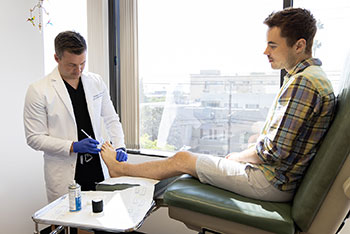
Platelet rich plasma, or PRP, is blood taken from a patient and spun in a centrifuge, concentrating the amount of platelets and growth factors. This plasma, containing a very high concentration of platelets, is re-injected into the site of injury or damage, inducing the body to repair damage to muscle, tendons, ligaments, and soft tissue. Although the body does this naturally when an injury occurs, the PRP helps speed the healing process.
Many injuries to the foot, especially those affecting tendons, do not heal well because poor blood supply to the area prevents healing platelets and growth factors carried by the blood from getting to the injury site. PRP injections can help fix this problem and speed recovery.
This is the first regenerative treatment ever for damaged muscles, tendons, and ligaments. It avoids the need for surgery, and as it requires only the insertion of a needle, is minimally invasive. The injection of PRP is done with the use of ultrasound to ensure the proper placement of the platelets.
Once the first injection is received, the patient will return to the doctor's approximately 2 to 3 weeks mlater to be checked on how well the treatment is moving along. As with most treatments, each patient's response is different. Based on a patient's condition, the doctor will make the decision about how many more injections will be needed. Acute and chronic injuries will require more injections than mild ones.
Common injuries of the feet such as ankle sprains, Achilles tendonitis, and plantar fasciitis, as well as acute and chronic tendon and joint diseases such as arthritis, can all be treated with PRP injections. For many, this therapy has lead to greatly reduced pain and increased function of the foot. Combining exercise or physical therapy with the PRP injections will help increase the success of the treatment.
This treatment, being minimally invasive, means that surgery can be avoided, in many cases, and recovery time cut down. Other benefits of PRP injections are a decrease in scar tissue and fibrosis to the damaged area, as well as increased range of motion, flexibility, and strength. The risks from using PRP injections as a treatment is very low as the patient is injected with their own blood, so that there is no risk of rejection or of foreign bloodborne disease. As with any injection into the body, there is a risk of infection, but this is very rare. Research is showing that PRP may have an anti-bacterial property that would further decrease the risk of infection.
PRP improves patient outcomes by enhancing the body’s normal healing process.
Platelet Rich Plasma therapy (also referred to as PRP) is an exciting new technique to speed the healing and recuperation of injured, damaged or diseased tissues. It naturally magnifies and concentrates the body’s own healing process to help resolve even difficult and stubborn foot and ankle ailments and injuries.
Unlike cortisone injections which can depress the healing process and often only temporalily masks symptoms, PRP enhances and stimulates healing.
Elite athletes and professional sports teams have relied on PRP therapy for years. It is now available to everyone.
